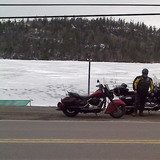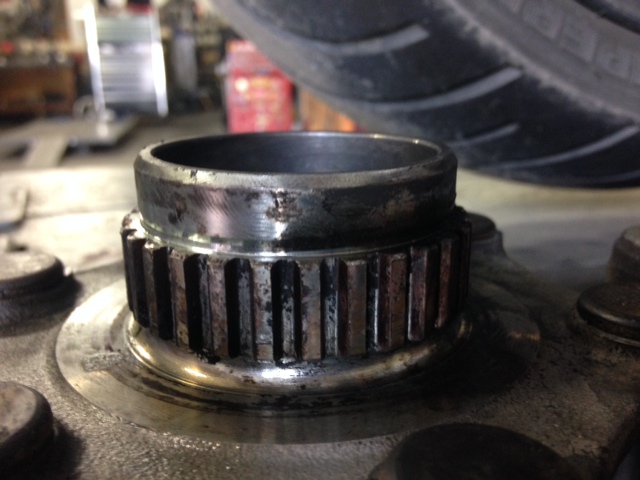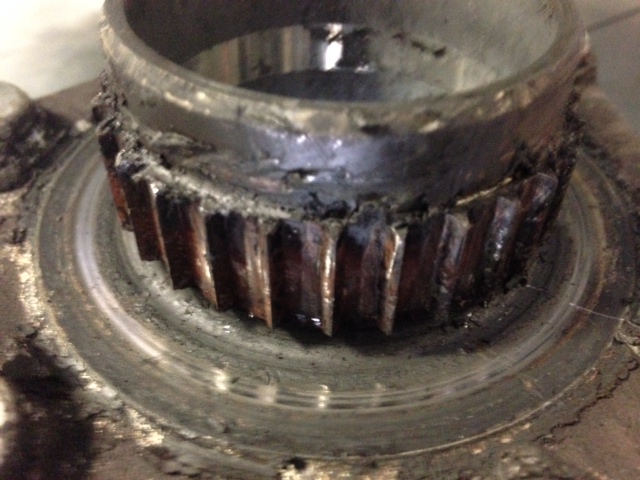-
Posts
2,307 -
Joined
-
Last visited
Content Type
Profiles
Forums
Gallery
Events
Store
Everything posted by Seaking
-
Though Doc's clutch system is affordable and effective as OEM replacement (nothing wrong with it), I didn't like where the friction zone was attained on the clutch lever.. The Barnett clutch replacement left the friction zone lever placement almost stock, though requiring a stronger pull depending on the strength of the plate ordered, you quickly get used to it. I found the extra money spent on the Barnett worth the cost for a near indestructible clutch system. As everything else, it's mostly a preference..
-
You can pick your nose, you can pick your friend.. but you can't pick your friend's nose.. remember the code!!
-
Generally speaking, on a motorcycle, if your hands are buzzed, and you can see blur in your mirrors, that's an indication of carbs being out of synch (high frequency). Synch'ing carbs isn't a difficult task but it can be tedious depending how meticulous you want to be with it. My 2006 Midnight (143K miles) started a heavy hand buzz (but clear mirrors) after I swapped out the contact points on my fuel pump.. and sure enough, for what ever reasons the gremlins decided, the carbs were out of synch enough to cause the buzz. Once the task was completed, the bars are smooth once again. but as others suggested, do check everything hanging off the front of the bike for anything looser than normal.. Cheers
-
I just recently went through having to repair my fuel pump (third time down on 06 Midnight 143K miles). The contact points are the easiest and best route to take. It is NOT difficult to install after removing the dead ones off the pump.. simple quick solder job and away ya go.. seriously, it's THAT easy that some folks don't bother taking the pump off the bike.. The cheap eBay pumps are worse than the Yamaha one so avoid those.. (cheap yes but you'll soon regret getting what ya paid for...) The bike is running SO much better now than it had all summer long (slowly failing pump rumbles the engine, now running much smoother) https://fortnine.ca/en/k-l-universal-fuel-pump-point-switch-kit-18-4615
-

Gas Issue Guage misleading reading
Seaking replied to Statussymbol's topic in Royal Star Venture Tech Talk ('99 - '13)
Most Japanese bikes will read roughly 8 to 10% higher in speed.. Don't know why they do that but they do.. On my 2006 RSV Midnight, it's 10% across the board.. 70 MPH means I'm actually doing 63 MPH. If you're doing the speed limit on the clock you can't be speeding.. I've been able to measure this against a car and my own GPS.. If you install a speedo healer type device to give you accurate speeds, your mileage will now start to record erroneously. I had tried one of these devices a while back and found I was registering around 8% less miles but had accurate speed.. I guess it's all up to personal choice.. I use my Garmin 450 Zumo as a speedo to keep my odo readings accurate.. Weird if I'm traveling with other bikers as they all complain I'm speeding accessively but actually doing the correct speed limit as they're seeing 10% overage in their speeds.. -

3rd Dead Fuel, installing Mr Gasket 42 S
Seaking replied to Seaking's topic in Royal Star Venture Tech Talk ('99 - '13)
Just a follow up after changing the contact points on my fuel pump.. I took the bike out for a test run earlier today and wow, what a difference a new set of points make on that pump! Whereas I used to have this weird almost 'lugging' like feel on the bike at certain higher speeds - high gears, it's gone now.. I would hazard to say that it was symptomatic to the fuel pump struggling to keep up with the fuel demand of the engine at that particular speed, gear and rpm. Try as I may, I could not duplicate that sensation on the long test run today. Should that sensation creep back up again later on, I'll be taking a look at those points again.. Time to plan a road trip -
Anyone know what the specs are on the tubes themselves? I have to replace the tubes on different manometers I have at hand.. Local shop doesn't carry this size.. (weird?!) Cheers
-

3rd Dead Fuel, installing Mr Gasket 42 S
Seaking replied to Seaking's topic in Royal Star Venture Tech Talk ('99 - '13)
Well the ol' girl is running again (finally).. I just wanted to add some insight to what happened in hopes that it will help someone along the way.. I did find an older article where someone found himself in the same situation as I did and ended up buying an OEM pump to fix the bike.. I think this may have been his problem.. I did end up purchasing the Mr Gasket 42s pump and after what seemed like a lot of running around, managed to find the appropriate fittings to make this pump work as shown in the write up in the tech library.. but I wasn't keen on having to rely on my memory to remember to turn off the fuel valve after each ride.. So though I have the 42s pump ready to roll, I picked up a set of contact points from this source: https://www.canadasmotorcycle.ca/k-l-universal-fuel-pump-point-switch-kit-18-4615.html The instructions are very simply but I did discover there was one little thing that they didn't hit upon that the novice mechanic might miss.. (not everything is painfully obvious to everyone).. When placing the new contact onto the pump, you have to ensure that the internal plate mates up with the groove on the solenoid piston.. otherwise nothing works.. And yes, it's very very easy to install the points onto the pump without making any contact with the solenoid at all.. Its only after doing a bit of trouble shooting that I looked at the old contact points unit and noticed the wear marks on the internal plate that would suggest the groove on the solenoid.. Once that was adjusted again, all is good. First turn of the key and the pump clicked away like a chipmunk on crack and the bike started with no choke on the first press of the starter.. wow.. nice!! So for $40 odd Canuck Bucks instead of big bucks for an OEM pump, this was a quick fix.. and yes, you might even be able to do it without having to remove the pump from the bike.. (road side repair if you have a gas torch to solder) I'll be keeping the 42s in the saddle bags and ordering another set of contact points just in case.. seeing how this is my third pump failure on this bike with 143K miles on it.. Thanks to those with helping advice and suggestions.. Time to go riding..! -

3rd Dead Fuel, installing Mr Gasket 42 S
Seaking replied to Seaking's topic in Royal Star Venture Tech Talk ('99 - '13)
Yeah, that's the one I was thinking of when ordering the My Gasket.. got the wrong one.. No worries, will have to remember to do the fuel valve thing.. Cheers -

3rd Dead Fuel, installing Mr Gasket 42 S
Seaking replied to Seaking's topic in Royal Star Venture Tech Talk ('99 - '13)
Thanks for that, is there a way to ascertain if there is a check valve? I'm just concerned as the years of never turning it off that I may just end up forgetting and causing more problems than it would be worth.. How about the wiring? Straight forward as to which wires goes where? Thanks all for feedback. Cheers -
I've ordered a Mr Gasket 42 S pump to replace a 2nd dead OEM fuel pump after 143K miles on the bike.... No used getting another OEM just to have it fail again. Seems straight forward for installation and such, however, I could not find info as to whether or not you have to turn the fuel valve off at end of riding day to prevent fuel pass through? Or is it basically plug and go as normal? Thanks for any info.
-

Drive Flange Advisory..
Seaking replied to Seaking's topic in Royal Star Venture Tech Talk ('99 - '13)
Considering that this was a used bike when I bought it, not sure what the previous owner(s) might have or not have done to this bike in the first 2 years of it's riding life.. seeing how black the fuel filter was with only 20K miles on it, I would hazard to guess it's been abused in it's early life. The other mating part of the flange is pristine looking. Its also usually the toughest part of the two pieces on all bike (project Suzuki bike has this same issue). Since I've had the bike, everything has been properly and frequently lubed as per tech bulletins and manuals.. And to be fair, I don't hammer down on throttle or compression braking. The only other factor is the VMax rear diff I unstalled a few years ago.. Though back then I don't recall seeing a lot of wear on the flange. I shouldn't think it would lead to premature wear and tear on the RSV parts.. What ever caused the premature wear out of the flange, I'm glad I got it changed out as the ride is even better now. -
At 135,000 miles on the odo, I had my bike in the shop for some work and found that my drive flange was severely worn.. Luckily, the shop had recently parted a RSV that met hard times and replaced mine with the salvaged piece for a great price. Wow, what a difference in ride. Very noticeable! Took the slop out of the drive train. Hard to explain what it felt like before but you could feel the drive train taking up slack whenever you put it under load with acceleration or engine compression braking, not matter how gentle you are with it. After the swap, the bike feels even more sure footed in the turns. I had thought that perhaps my swing arm bearings needed attention but they were fine.. It was the drive flange knocking against the gears in both direction. In the photos below, you can see how much wear there is on the old compared to the new. So next time you have your rear wheel off, have a look at the drive flange.. is it in good shape or looking like mine did? What it should look like.. What mine looked like after 135,000 miles..
-

re-wire emergency flashers to battery
Seaking replied to videoarizona's topic in Royal Star Venture Tech Talk ('99 - '13)
I had mine wired so that the key is not required for the hazard lights. It was a matter of simply jumping one wire in the harness found under the main fairing. It also made the signal lights work without the key. I have the notes here somewhere, just have to find it.. But it was simple thing to do. -
Its so cold out here on the coast that even in summer you most likely will never hear it come on.. the only time I hear mine is when I'm road tripping through the USA.. Its June but the temps dip near the freezing mark at night around here.. brrr. But no harm in having it testing to make sure it's working.. The first time I had the valves done (by Goose), the floats were adjusted and carbs cleaned. The last time I had the valves done, last summer, I noticed a lot of carbon build up on the valve stems and had those cleaned away.. carbs were still clean after so so many miles..
-

lightweight touring bike
Seaking replied to cruiserlover's topic in Royal Star Venture Tech Talk ('99 - '13)
Yup, thanks for posting that.. It seems like a lot of work to attain something that's already available out there with a lighter foot print and lower C of G.. But I like my RSV just the way it is.. big heavy and fun to ride with a VMax rear.. -
The bulb itself has a blue tinge to it but the light output is white..
-
It's an easy one man job for sure.. It's not much of a juggling act even with the calipers still installed but you have to line everything up.. easier with the calipers off and re-installing them afterwards. However, I just sit on my little rolling stool and balance the wheel on my feet to line up and lift the wheel into place to install the axle etc.
-

Custom Dynamic LED thoughts
Seaking replied to sleadhed's topic in Royal Star Venture Tech Talk ('99 - '13)
I've had them on my RSV for many years now, still running brighter than stock. They will flash faster than stock if no load equalizer installed. I've had car drivers tell me "hey I noticed your signal lights blink fast.. (thinking the other bulb is blown).." Well at least they "saw" the signal light, thanks! I orignally had white ones in the front (permissable by law here) but later replaced them with ambers as the white ones blended in a little too much with the LED highway lights.. A super Bright tail / brake light is also indispensible.. -

2005 RSV is now home
Seaking replied to videoarizona's topic in Royal Star Venture Tech Talk ('99 - '13)
If I remember properly, the new leveling links are shorter to raise the rear of the bike (due to the way the linkage works in the back).. -

2005 RSV is now home
Seaking replied to videoarizona's topic in Royal Star Venture Tech Talk ('99 - '13)
When you say "slow turns", do you mean as in crawling speed turns or slow road speeds? I know that a loose neck will feel as you describe when doing slow tight turns, feels like the steering wants to fall into the steering locks but not so pronounced when taking 30 mph curves on the road. If you're doing slow tight turns in a parking lot, there is a lot of top weight on this bike and it will feel like it wants to fall over but you counter that with rear brake and revs while in the friction zone. More will be revealed to you when you get the bike up on a hoist. As earlier described about the handle bar test, another test is to remove the key cover (so the risers don't hit it especially if you have extenders) and pushing the bars over to one side and the other until the forks hit the steering stops. The bars should bounce back and come back to a rest against the stops.. but if the bars bounce severeal times then it indicates the steering head is loose. If it doesn't bounce, it's too tight. When you rotate the steering from full left to full right, see if you can feel any grabbing, ratcheting or weird spots.. Then grasp the front wheel at the 3 o'clock position (looking at it from the right side) and give it a push pull tug. You should not feel any knocking at all. If you do, its a loose neck. There is an article write up about the poor man's neck tightening which, IMHO should only be used for minor adjustments. If you're doing a full turn on the nut, then it might be time to relube. And if you're going to relube, why not replace the old bearings with new ones since you have to remove them to relube anyway.. I replaced mine at around the 60K miles mark after that I95 pothole hit as the steering got looser and looser the following year. It's been solid ever since. But a new tire and steering neck checks will reveal more to you as to what is going on with the bike.. Best of luck! -

2005 RSV is now home
Seaking replied to videoarizona's topic in Royal Star Venture Tech Talk ('99 - '13)
It feels like over steer? Have you checked the front tire for possible damage or belt breaks? A few years back I had hit a massive pothole on the I95 on my way to the Dragon's Tail and the ride got worse and worse on that trip. It wasn't till after I had gotten home that it was revealed that the tire was suffering from broken belts. It made the bike scary in turns.. Additionally, is there any chance the bike's geometry was altered in the negative, eg. lowered rear? -

Progressive Suspension Air Fork Balance Kit
Seaking replied to Maritimer's topic in Royal Star Venture Tech Talk ('99 - '13)
The kit wasn't all that good, leaked more often than not. The connectors that go on the shrader valves weren't that good.. I had one installed but took it off after a while.. A little too flimsy for the task at hand. -
I had tried Doc's spring kit and though it's good for the price, I didn't like where the friction was felt on the lever. I then opted for the Barnett heavy duty spring and never looked back. I had so badly burnt out my clutch plates earlier on with the OEM spring that I replaced them with the Barnett plates and they've been holding up super well since then. The Barnett system is more expensive but works well. It requires more pull on the lever than stock but you get used to it in no time.



